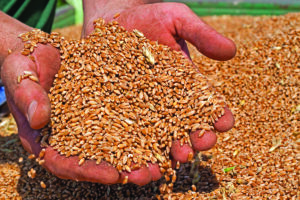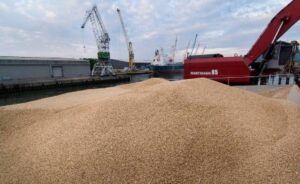
The UK is working with international partners to find ways to resume grain exports from Ukraine, a Downing Street spokesperson said on Saturday.
According to The Guardian, according to her, the UK was involved in “intensive work … with international partners to find ways to resume the export of grain from Ukraine to avert a global food crisis.”
Prime Minister of the UK Boris Johnson had a telephone conversation with Ukrainian President Volodymyr Zelensky and told him that London would work with G7 partners to ” push for urgent progress” on the issue.
During the conversation, they also agreed on the next steps to ensure “safe shipping lanes.”

Ukraine in 2022 can harvest a crop of 66 million tons of grain, leguminous and oilseeds, which is 1.6 times less compared to the record harvest over the years of independence in 2021, when 106 million tons were harvested.
As reported on the website of the association Ukrainian Club of Agrarian Business (UCAB) on Thursday evening, this year it is expected to produce 50.4 million tons of grains and legumes (1.7 times less than in 2021), and 16 million tons of oilseeds ( 41.2% less),
According to her, this year the wheat harvest is expected to be 18 million tons (-44% by 2021), corn – 25.7 million tons (-39%), barley – 5.2 million tons (-55%).
As for oilseeds, in 2022 it is expected to produce 10.6 million tons of sunflower (-35% by 2021), soybeans – 3.0 million tons (-14%), rapeseed – 2.7 million tons (-22% ).
According to the UCAB, soybean and rapeseed show the lowest rates of decline in the expected gross harvest. This is due to the relatively small mass of their crop, combined with a high price for it, which facilitates logistical issues when exporting these oilseeds.
The Association emphasized that the decrease in sown area in 2022 was due to the partial occupation of part of the territory of Ukraine by Russian troops, the inability to sow in fields mined by Russians, and also due to damage to the material and technical base of Ukrainian farmers.
In addition, this year, yields are expected to decrease by about 10% due to the inability of some farms to comply with all technological procedures.
“In any case, the grown grains and oilseeds will be enough to meet the domestic needs of Ukrainians, as well as partial export sales. The main thing is that exports recover to their previous volumes, and farmers have sufficient financial resources to carry out the next sowing season,” summed up the UCAB in forecast
As reported, in 2021 Ukraine harvested a record harvest of grains, legumes and oilseeds in the amount of 106 million tons: grains and legumes – UAH 84 million and oilseeds – 22.6 million tons.
In 2020, the harvest of grains, legumes and oilseeds amounted to 84 million tons, including grains and legumes – 65.5 million tons, oilseeds – 18.5 million tons.

For the period from May 1 through May 19, 2022, Ukraine exported 643,000 tonnes of grain crops, while the export rate increased: for the week from May 12 to May 19, 344,000 tonnes were delivered to foreign markets, while for a week and a half of this month (from May 1 through May 12) this figure amounted to 299,000 tonnes.
However, as reported on the website of the Ministry of Agrarian Policy and Food on Thursday, the rate of grain exports since the beginning of May this year is 2.8 times lower compared to the same period last year (1.8 million tonnes were exported from May 1 to May 19, 2021).
Such a decline in the ministry is explained by the blockade of Ukrainian seaports, a key export infrastructure, by the troops of the aggressor country of the Russian Federation.
According to the Ministry of Agrarian Policy, since the beginning of 2021/22 (July-June) and as of May 19, the country has exported 46.51 million tonnes of grain and leguminous crops, which is 13.8% higher than the figures for the same date of the previous year. This excess of last year’s indicators is caused by a record harvest in the current year and the high intensity of its export before the Russian invasion on February 24.
In total, from the beginning of 2021/22 as of May 19, 2022, Ukraine had exported 18.54 million tonnes of wheat (18.7% more compared to the same date in 2020/21), 21.83 million tonnes of corn (6.9% more), 5.68 million tonnes of barley (37.2% more), 70,600 tonnes of flour (35.7% less).
For the period from May 12 to May 19, 333,000 tonnes of corn, 10,000 tonnes of wheat and 600 tonnes of flour were exported. Barley and rye were not exported during the specified period. In total, since the beginning of May, 617,000 tonnes of corn, 16,000 tonnes of wheat, 8,000 tonnes of barley and 1,100 tonnes of flour have been exported.
If to compare the current data of the agro-industrial complex portal with its indicators as of February 21, the last update before the Russian military invasion of Ukraine, it could be established that during the war Ukraine exported 3.97 million tonnes of grain and leguminous crops, of which 3.14 million tonnes of corn, 690,000 million tonnes of wheat, 110,000 tonnes of barley and 4,000 tonnes of flour.

The export of Ukrainian agricultural products through the EU countries, including taking into account deliveries through the Danube river ports, cannot exceed 1.5 million tons per month under any circumstances, while before the blockade of its seaports by the Russian troops, the country could transship more than 5 million tons per month. million tons of agricultural crops per month.
The opinion about the need for Ukraine to work on the launch of new logistics routes and export directions was expressed by First Deputy Minister of Agrarian Policy and Food Taras Vysotsky during the expert discussion “Blocked trade: can Ukraine increase export capacity” on Friday.
“We preliminary calculated that up to one and a half million tons is still the maximum. Therefore, I think that we can count on this until May, and then only alternative directions,” Vysotsky said.
He clarified that Ukraine has enough agricultural products for export, and Ukrainian farmers can supply as much grain as they need to foreign markets, and the volume of its exports is limited only by logistics.
As reported with reference to the Minister of Agrarian Policy Mykola Solsky, in April 2022 Ukraine exported 1.09 million tons of grain mainly through Romanian ports, which is more than five times higher than in March.
According to him, most of the export deliveries from Ukraine were carried out in April through the river ports of the Danube, since the Ukrainian Black Sea ports are blocked by Russian warships.
At the same time, the logistics of Ukrainian agricultural products through Romania may become more complicated and slow down in June, when a new crop of Romanian, Serbian, Hungarian and Bulgarian winter wheat and barley will begin to arrive at the seaports of this country and will create competition with supplies from Ukraine.

The export of Ukrainian agricultural products through the EU countries, taking into account deliveries through the Danube river ports, cannot exceed 1.5 million tonnes per month under any circumstances, while before the blockade of its seaports by the Russian troops, the country could monthly transship over 5 million tonnes of agricultural crops per month.
An opinion about a need for Ukraine to work on the launch of new logistics routes and export directions was expressed by First Deputy Minister of Agrarian Policy and Food Taras Vysotsky during the expert discussion “Blocked trade: can Ukraine increase export capacity” on Friday.
“We preliminary calculated that up to 1.5 million tonnes are still the maximum. Therefore, I think that we can count on this until May, and then only alternative directions,” Vysotsky said.
He clarified that Ukraine has enough agricultural products for export, and Ukrainian farmers can supply as much grain as they need to foreign markets, and the volume of its exports is limited only by logistics.
As reported with reference to Minister of Agrarian Policy Mykola Solsky, in April 2022 Ukraine exported 1.09 million tonnes of grain mainly through Romanian ports, which is more than five times higher than in March.
According to him, most of the export deliveries from Ukraine were carried out in April through the Danube river ports, since the Ukrainian Black Sea ports are blocked by Russian warships.
At the same time, the logistics of Ukrainian agricultural products through Romania may become more complicated and slow down in June, when a new crop of Romanian, Serbian, Hungarian and Bulgarian winter wheat and barley will begin to arrive at the seaports of this country and will create competition with supplies from Ukraine.